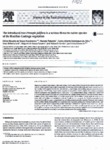Use este identificador para citar ou linkar para este item:
http://www.alice.cnptia.embrapa.br/alice/handle/doc/983347Registro completo de metadados
| Campo DC | Valor | Idioma |
|---|---|---|
| dc.contributor.author | NASCIMENTO, C. E. de S. | pt_BR |
| dc.contributor.author | TABARELLI, M. | pt_BR |
| dc.contributor.author | SILVA, C. A. D. da | pt_BR |
| dc.contributor.author | LEAL, I. R. | pt_BR |
| dc.contributor.author | TAVARES, W. de S. | pt_BR |
| dc.contributor.author | SERRÃO, J. E. | pt_BR |
| dc.contributor.author | ZANUNCIO, J. C. | pt_BR |
| dc.date.accessioned | 2014-03-25T11:11:11Z | pt_BR |
| dc.date.available | 2014-03-25T11:11:11Z | pt_BR |
| dc.date.created | 2014-03-25 | pt_BR |
| dc.date.issued | 2014 | pt_BR |
| dc.identifier.citation | Science of the Total Environment, v. 481, p. 108-113, 2014. | pt_BR |
| dc.identifier.uri | http://www.alice.cnptia.embrapa.br/alice/handle/doc/983347 | pt_BR |
| dc.description | Despite its economic importance in the rural context, the Prosopis juliflora tree species has already invaded millions of hectares globally (particularly rangelands), threatening native biodiversity and rural sustainability. Here we examine seedling growth (leaf area, stem diameter, plant height) and seedling mortality across five native plant species of the Caatinga vegetation in response to competition with P. juliflora. Two sowing treatments with 10 replications were adopted within a factorial 2 × 5 randomized block design. Treatments consisted of P. juliflora seeds sowed with seeds of Caesalpinia ferrea, Caesalpinia microphylla, Erythrina velutina, Mimosa bimucronata and Mimosa tenuiflora (one single native species per treatment), while seeds of native species sowed without P. juliflora were adopted as controls. Overall, our results suggest that P. juliflora can reduce seedling growth by half and cause increased seedlingmortality amongwoody plant species.Moreover, native species exhibit different levels of susceptibility to competitionwith P. juliflora, particularly in terms of plant growth. Such a superior competitive ability apparently permits P. juliflora to establishmonospecific stands of adult trees, locally displacing native species or limiting their recruitment. The use of less sensitive species, such as C. ferrea and M. tenuiflora, to restore native vegetation before intensive colonization by P. juliflora should be investigated as an effective approach for avoiding its continuous spread across the Caatinga region. | pt_BR |
| dc.language.iso | eng | eng |
| dc.rights | openAccess | eng |
| dc.subject | Invasão de plantas | pt_BR |
| dc.title | The introduced tree Prosopis juliflora is a serious threat to native species of the Brazilian Caatinga vegetation. | pt_BR |
| dc.type | Artigo de periódico | pt_BR |
| dc.date.updated | 2017-04-25T11:11:11Z | pt_BR |
| dc.subject.thesagro | Algaroba | pt_BR |
| dc.subject.thesagro | Floresta | pt_BR |
| dc.subject.thesagro | Caatinga | pt_BR |
| dc.subject.thesagro | Biodiversidade | pt_BR |
| dc.subject.thesagro | Espécie Nativa | pt_BR |
| dc.subject.thesagro | Prosopis Juliflora | pt_BR |
| dc.subject.thesagro | Vegetação | pt_BR |
| dc.subject.nalthesaurus | Forestry | pt_BR |
| riaa.ainfo.id | 983347 | pt_BR |
| riaa.ainfo.lastupdate | 2017-04-25 | pt_BR |
| dc.identifier.doi | 10.1016/j.scitotenv.2014.02019 | pt_BR |
| dc.contributor.institution | CLOVIS EDUARDO DE SOUZA NASCIMENTO, CPATSA; MARCELO TABARELLI, UFPE; CARLOS ALBERTO DOMINGUES DA SILVA, CNPA; INARA ROBERTA LEAL, UFPE; WAGNER DE SOUZA TAVARES, UFV; JOSÉ EDUARDO SERRÃO, UFV; JOSÉ COLA ZANUNCIO, UFV. | pt_BR |
| Aparece nas coleções: | Artigo em periódico indexado (CPATSA)  | |
Arquivos associados a este item:
| Arquivo | Descrição | Tamanho | Formato | |
|---|---|---|---|---|
| 51984.pdf | 5,37 MB | Adobe PDF |  Visualizar/Abrir |









